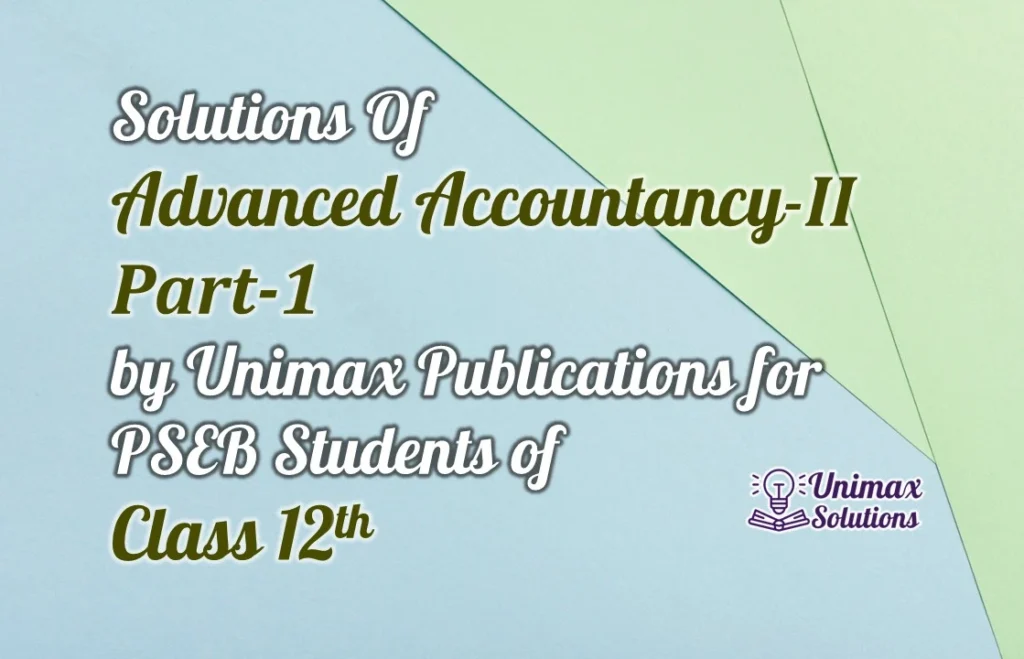
Advertisement
In the article of Solution of Advanced Accountancy II Part 1 by Unimax Publications for PSEB Students of Class 12, We have solved the Advanced Accountancy II Part 1 by Unimax Publications for Class 12. These books are covered the syllabus provided by the Punjab School Education Board(PSEB):
Solution of Advanced Accountancy II Part 1 by Unimax Publications Class 12:

The Chapter-wise Solution of Advanced Accountancy II Part 1 Class 12 by Unimax is shown below:

This chapter explores the accounting aspects of non-profit organizations, focusing on their unique characteristics and objectives. It begins by defining non-profit organizations and highlighting the key distinctions between these entities and profit-oriented businesses. The chapter then delves into the specific accounting principles and procedures applicable to non-profit organizations. Topics covered include receipt and payment accounts, income and expenditure accounts, the preparation of balance sheets, and the treatment of items such as subscriptions, donations, legacies, and endowments. Through the use of practical examples and illustrations, students gain a clear understanding of the accounting methods employed by non-profit organizations.
Chapter No. 2 – Partnership Accounts – I (Basic Concepts)
In this chapter, the fundamental concepts and terminology associated with partnerships are introduced to lay the groundwork for partnership accounting. It commences by defining what constitutes a partnership and outlining its distinguishing features compared to other business structures. The chapter covers various aspects including partnership deeds, partnership agreements, and the rights, duties, and responsibilities of partners. Additionally, it provides an overview of different partner types, such as active, sleeping, nominal, and partner by estoppel. Furthermore, the chapter discusses the methods employed for profit distribution among partners, such as fixed ratio, fluctuating ratio, and interest on capital. Practical examples and illustrations are incorporated to facilitate a comprehensive understanding of the foundational concepts.
This Chapter centers around the concept of goodwill in partnership accounting. It begins by elucidating the significance and meaning of goodwill within a partnership firm. The chapter covers topics such as the factors influencing goodwill value, methods of goodwill calculation (average profit method, super profit method, and capitalization method), and the treatment of goodwill in various scenarios, such as the admission, retirement, or death of a partner. Moreover, the chapter discusses the relevant accounting entries about the valuation and treatment of goodwill. To enhance comprehension, practical examples, and case studies are included to illustrate the computation and accounting treatment of goodwill in different contexts.
Chapter No. 4 – Partnership Accounts – III (Change in Profit Sharing Ratio among Existing Partners)
This Chapter concentrates on the accounting aspects related to a change in the profit-sharing ratio among existing partners. It begins by exploring the reasons for altering the profit-sharing ratio and the implications for partners. The chapter covers topics including the adjustment of accumulated profits and losses, revaluation of assets and liabilities, treatment of reserves, and the adjustment of capital accounts. Furthermore, the chapter explains the necessary accounting entries to record the change in the profit-sharing ratio and the resulting adjustments in partners’ capital accounts. Numerous numerical examples and practice questions are provided to enable students to grasp and apply the concepts effectively
This chapter focuses on the accounting treatment involved in admitting a new partner into an existing partnership. The chapter begins by highlighting the reasons and benefits of admitting a new partner and proceeds to cover topics such as methods of admitting a partner, including the gaining ratio and sacrificing ratio, and the determination of the new profit-sharing ratio. Additionally, the chapter discusses the treatment of goodwill, revaluation of assets and liabilities, adjustment of accumulated profits and losses, and the preparation of the new partner’s capital account. Practical examples and case studies are incorporated to enhance understanding of the admission of a new partner and its impact on the partnership’s financial accounts.
Advertisement
Chapter No. 6 – Partnership Accounts – V (Retirement and Death of A Partner)
This Chapter delves into the accounting treatment of the retirement and death of a partner in a partnership firm. The chapter begins by discussing the implications and reasons for a partner’s retirement or death within the partnership structure. It covers topics such as the calculation of the retiring or deceased partner’s share of goodwill, the adjustment of accumulated profits and losses, the revaluation of assets and liabilities, and the distribution of the partner’s capital. Furthermore, the chapter explains the necessary accounting entries to record the retirement or death of a partner and the subsequent adjustments in the remaining partners’ capital accounts. Practical examples and case studies are provided to illustrate the accounting treatment in various scenarios.
This Chapter focuses on the accounting aspects involved in the dissolution of a partnership firm. The chapter begins by explaining the meaning and reasons for the dissolution of a partnership. It covers topics such as the different modes of dissolution, including dissolution by agreement, dissolution with the occurrence of a specific event, and dissolution by court order. The chapter discusses the preparation of the realization account, the treatment of assets, liabilities, and reserves, and the settlement of partners’ capital and loan accounts. Additionally, it explains the necessary accounting entries to record the dissolution and the subsequent distribution of the firm’s assets and liabilities among the partners. Practical examples and case studies are included to enhance understanding of the accounting procedures involved in the dissolution of a partnership firm.
Advertisement






